Bingxuan Wang
DeepSeek-V3 Technical Report
Dec 27, 2024



Abstract:We present DeepSeek-V3, a strong Mixture-of-Experts (MoE) language model with 671B total parameters with 37B activated for each token. To achieve efficient inference and cost-effective training, DeepSeek-V3 adopts Multi-head Latent Attention (MLA) and DeepSeekMoE architectures, which were thoroughly validated in DeepSeek-V2. Furthermore, DeepSeek-V3 pioneers an auxiliary-loss-free strategy for load balancing and sets a multi-token prediction training objective for stronger performance. We pre-train DeepSeek-V3 on 14.8 trillion diverse and high-quality tokens, followed by Supervised Fine-Tuning and Reinforcement Learning stages to fully harness its capabilities. Comprehensive evaluations reveal that DeepSeek-V3 outperforms other open-source models and achieves performance comparable to leading closed-source models. Despite its excellent performance, DeepSeek-V3 requires only 2.788M H800 GPU hours for its full training. In addition, its training process is remarkably stable. Throughout the entire training process, we did not experience any irrecoverable loss spikes or perform any rollbacks. The model checkpoints are available at https://github.com/deepseek-ai/DeepSeek-V3.
DeepSeek-VL2: Mixture-of-Experts Vision-Language Models for Advanced Multimodal Understanding
Dec 13, 2024



Abstract:We present DeepSeek-VL2, an advanced series of large Mixture-of-Experts (MoE) Vision-Language Models that significantly improves upon its predecessor, DeepSeek-VL, through two key major upgrades. For the vision component, we incorporate a dynamic tiling vision encoding strategy designed for processing high-resolution images with different aspect ratios. For the language component, we leverage DeepSeekMoE models with the Multi-head Latent Attention mechanism, which compresses Key-Value cache into latent vectors, to enable efficient inference and high throughput. Trained on an improved vision-language dataset, DeepSeek-VL2 demonstrates superior capabilities across various tasks, including but not limited to visual question answering, optical character recognition, document/table/chart understanding, and visual grounding. Our model series is composed of three variants: DeepSeek-VL2-Tiny, DeepSeek-VL2-Small and DeepSeek-VL2, with 1.0B, 2.8B and 4.5B activated parameters respectively. DeepSeek-VL2 achieves competitive or state-of-the-art performance with similar or fewer activated parameters compared to existing open-source dense and MoE-based models. Codes and pre-trained models are publicly accessible at https://github.com/deepseek-ai/DeepSeek-VL2.
DeepSeek-Coder-V2: Breaking the Barrier of Closed-Source Models in Code Intelligence
Jun 17, 2024



Abstract:We present DeepSeek-Coder-V2, an open-source Mixture-of-Experts (MoE) code language model that achieves performance comparable to GPT4-Turbo in code-specific tasks. Specifically, DeepSeek-Coder-V2 is further pre-trained from an intermediate checkpoint of DeepSeek-V2 with additional 6 trillion tokens. Through this continued pre-training, DeepSeek-Coder-V2 substantially enhances the coding and mathematical reasoning capabilities of DeepSeek-V2, while maintaining comparable performance in general language tasks. Compared to DeepSeek-Coder-33B, DeepSeek-Coder-V2 demonstrates significant advancements in various aspects of code-related tasks, as well as reasoning and general capabilities. Additionally, DeepSeek-Coder-V2 expands its support for programming languages from 86 to 338, while extending the context length from 16K to 128K. In standard benchmark evaluations, DeepSeek-Coder-V2 achieves superior performance compared to closed-source models such as GPT4-Turbo, Claude 3 Opus, and Gemini 1.5 Pro in coding and math benchmarks.
QDA-SQL: Questions Enhanced Dialogue Augmentation for Multi-Turn Text-to-SQL
Jun 15, 2024Abstract:Fine-tuning large language models (LLMs) for specific domain tasks has achieved great success in Text-to-SQL tasks. However, these fine-tuned models often face challenges with multi-turn Text-to-SQL tasks caused by ambiguous or unanswerable questions. It is desired to enhance LLMs to handle multiple types of questions in multi-turn Text-to-SQL tasks. To address this, we propose a novel data augmentation method, called QDA-SQL, which generates multiple types of multi-turn Q\&A pairs by using LLMs. In QDA-SQL, we introduce a novel data augmentation method incorporating validation and correction mechanisms to handle complex multi-turn Text-to-SQL tasks. Experimental results demonstrate that QDA-SQL enables fine-tuned models to exhibit higher performance on SQL statement accuracy and enhances their ability to handle complex, unanswerable questions in multi-turn Text-to-SQL tasks. The generation script and test set are released at https://github.com/mcxiaoxiao/QDA-SQL.
Complementing Event Streams and RGB Frames for Hand Mesh Reconstruction
Mar 12, 2024Abstract:Reliable hand mesh reconstruction (HMR) from commonly-used color and depth sensors is challenging especially under scenarios with varied illuminations and fast motions. Event camera is a highly promising alternative for its high dynamic range and dense temporal resolution properties, but it lacks key texture appearance for hand mesh reconstruction. In this paper, we propose EvRGBHand -- the first approach for 3D hand mesh reconstruction with an event camera and an RGB camera compensating for each other. By fusing two modalities of data across time, space, and information dimensions,EvRGBHand can tackle overexposure and motion blur issues in RGB-based HMR and foreground scarcity and background overflow issues in event-based HMR. We further propose EvRGBDegrader, which allows our model to generalize effectively in challenging scenes, even when trained solely on standard scenes, thus reducing data acquisition costs. Experiments on real-world data demonstrate that EvRGBHand can effectively solve the challenging issues when using either type of camera alone via retaining the merits of both, and shows the potential of generalization to outdoor scenes and another type of event camera.
DeepSeek-VL: Towards Real-World Vision-Language Understanding
Mar 11, 2024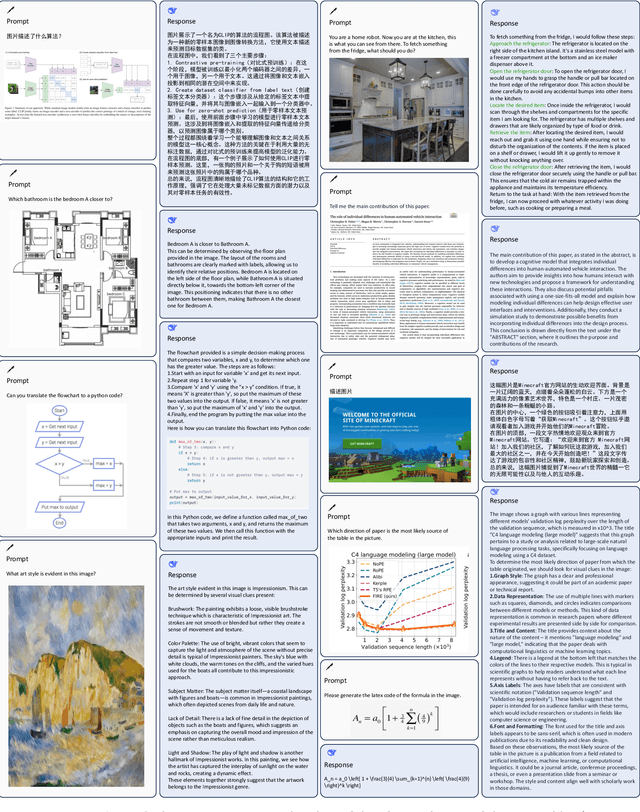
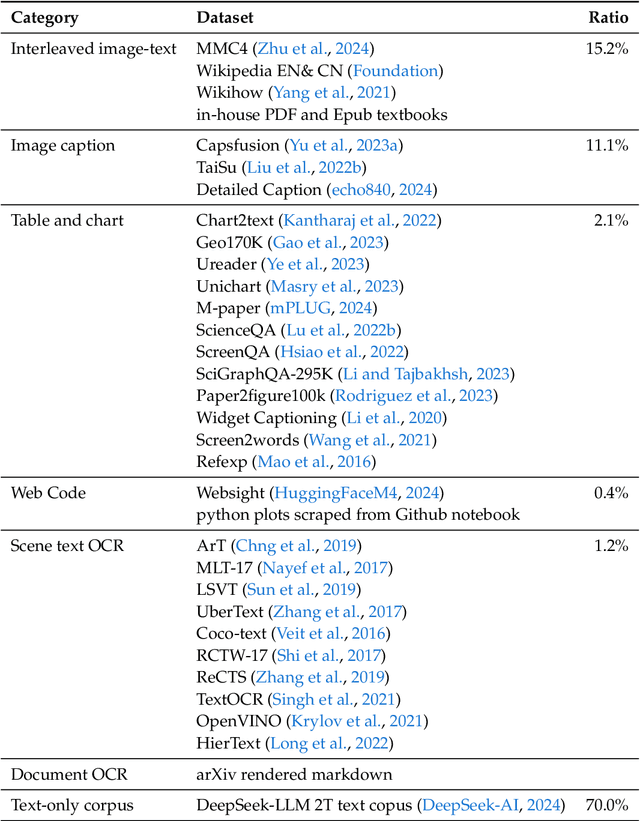
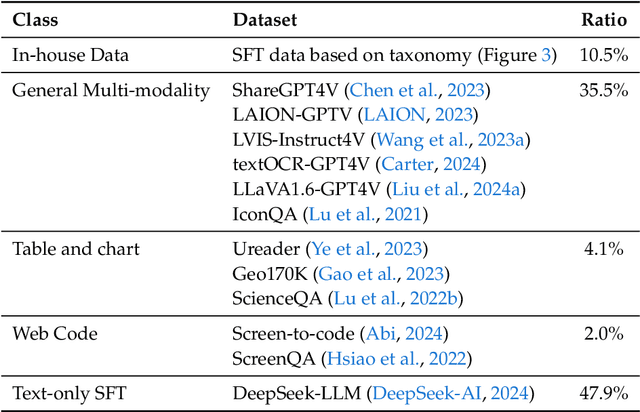
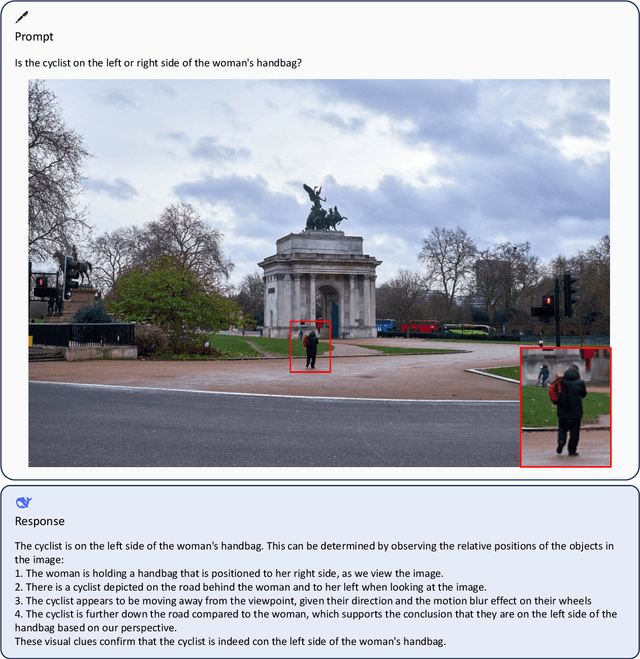
Abstract:We present DeepSeek-VL, an open-source Vision-Language (VL) Model designed for real-world vision and language understanding applications. Our approach is structured around three key dimensions: We strive to ensure our data is diverse, scalable, and extensively covers real-world scenarios including web screenshots, PDFs, OCR, charts, and knowledge-based content, aiming for a comprehensive representation of practical contexts. Further, we create a use case taxonomy from real user scenarios and construct an instruction tuning dataset accordingly. The fine-tuning with this dataset substantially improves the model's user experience in practical applications. Considering efficiency and the demands of most real-world scenarios, DeepSeek-VL incorporates a hybrid vision encoder that efficiently processes high-resolution images (1024 x 1024), while maintaining a relatively low computational overhead. This design choice ensures the model's ability to capture critical semantic and detailed information across various visual tasks. We posit that a proficient Vision-Language Model should, foremost, possess strong language abilities. To ensure the preservation of LLM capabilities during pretraining, we investigate an effective VL pretraining strategy by integrating LLM training from the beginning and carefully managing the competitive dynamics observed between vision and language modalities. The DeepSeek-VL family (both 1.3B and 7B models) showcases superior user experiences as a vision-language chatbot in real-world applications, achieving state-of-the-art or competitive performance across a wide range of visual-language benchmarks at the same model size while maintaining robust performance on language-centric benchmarks. We have made both 1.3B and 7B models publicly accessible to foster innovations based on this foundation model.
DeepSeek LLM: Scaling Open-Source Language Models with Longtermism
Jan 05, 2024



Abstract:The rapid development of open-source large language models (LLMs) has been truly remarkable. However, the scaling law described in previous literature presents varying conclusions, which casts a dark cloud over scaling LLMs. We delve into the study of scaling laws and present our distinctive findings that facilitate scaling of large scale models in two commonly used open-source configurations, 7B and 67B. Guided by the scaling laws, we introduce DeepSeek LLM, a project dedicated to advancing open-source language models with a long-term perspective. To support the pre-training phase, we have developed a dataset that currently consists of 2 trillion tokens and is continuously expanding. We further conduct supervised fine-tuning (SFT) and Direct Preference Optimization (DPO) on DeepSeek LLM Base models, resulting in the creation of DeepSeek Chat models. Our evaluation results demonstrate that DeepSeek LLM 67B surpasses LLaMA-2 70B on various benchmarks, particularly in the domains of code, mathematics, and reasoning. Furthermore, open-ended evaluations reveal that DeepSeek LLM 67B Chat exhibits superior performance compared to GPT-3.5.
Differentiable Feature Aggregation Search for Knowledge Distillation
Aug 02, 2020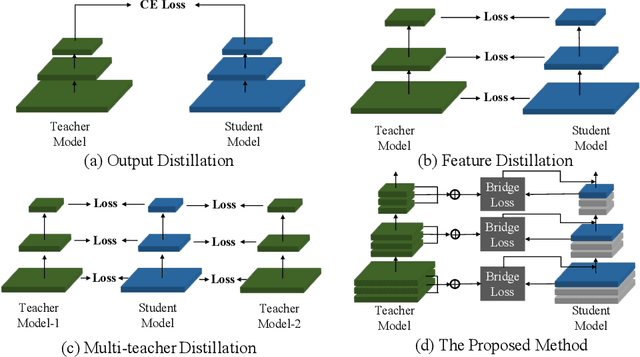
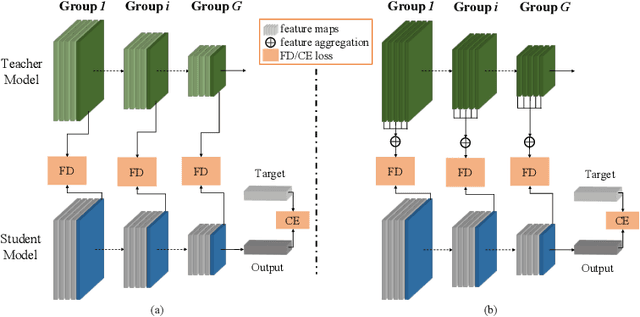

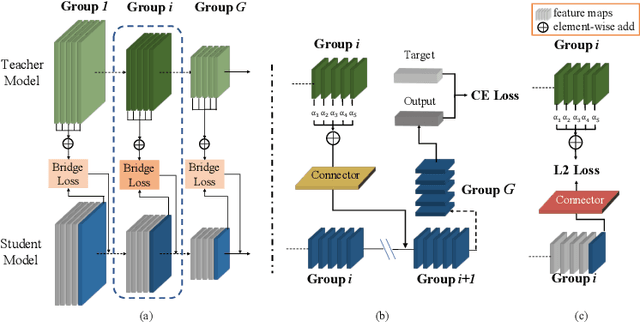
Abstract:Knowledge distillation has become increasingly important in model compression. It boosts the performance of a miniaturized student network with the supervision of the output distribution and feature maps from a sophisticated teacher network. Some recent works introduce multi-teacher distillation to provide more supervision to the student network. However, the effectiveness of multi-teacher distillation methods are accompanied by costly computation resources. To tackle with both the efficiency and the effectiveness of knowledge distillation, we introduce the feature aggregation to imitate the multi-teacher distillation in the single-teacher distillation framework by extracting informative supervision from multiple teacher feature maps. Specifically, we introduce DFA, a two-stage Differentiable Feature Aggregation search method that motivated by DARTS in neural architecture search, to efficiently find the aggregations. In the first stage, DFA formulates the searching problem as a bi-level optimization and leverages a novel bridge loss, which consists of a student-to-teacher path and a teacher-to-student path, to find appropriate feature aggregations. The two paths act as two players against each other, trying to optimize the unified architecture parameters to the opposite directions while guaranteeing both expressivity and learnability of the feature aggregation simultaneously. In the second stage, DFA performs knowledge distillation with the derived feature aggregation. Experimental results show that DFA outperforms existing methods on CIFAR-100 and CINIC-10 datasets under various teacher-student settings, verifying the effectiveness and robustness of the design.
Alchemy: Techniques for Rectification Based Irregular Scene Text Recognition
Aug 30, 2019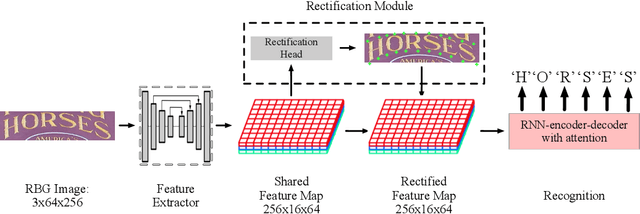
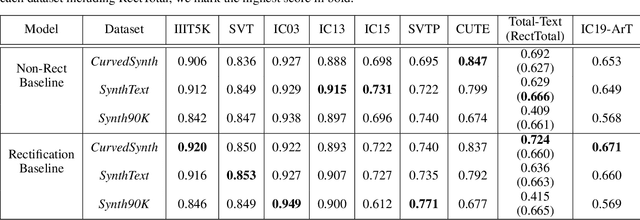


Abstract:Reading text from natural images is challenging due to the great variety in text font, color, size, complex background and etc.. The perspective distortion and non-linear spatial arrangement of characters make it further difficult. While rectification based method is intuitively grounded and has pushed the envelope by far, its potential is far from being well exploited. In this paper, we present a bag of tricks that prove to significantly improve the performance of rectification based method. On curved text dataset, our method achieves an accuracy of 89.6% on CUTE-80 and 76.3% on Total-Text, an improvement over previous state-of-the-art by 6.3% and 14.7% respectively. Furthermore, our combination of tricks helps us win the ICDAR 2019 Arbitrary-Shaped Text Challenge (Latin script), achieving an accuracy of 74.3% on the held-out test set. We release our code as well as data samples for further exploration at https://github.com/Jyouhou/ICDAR2019-ArT-Recognition-Alchemy
 Add to Chrome
Add to Chrome Add to Firefox
Add to Firefox Add to Edge
Add to Edge